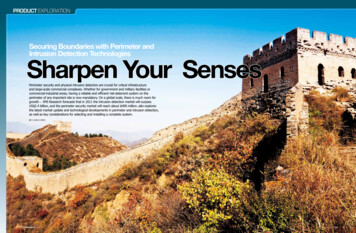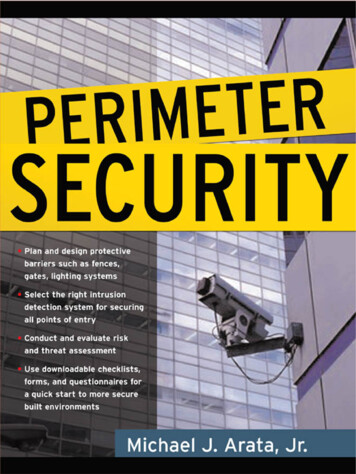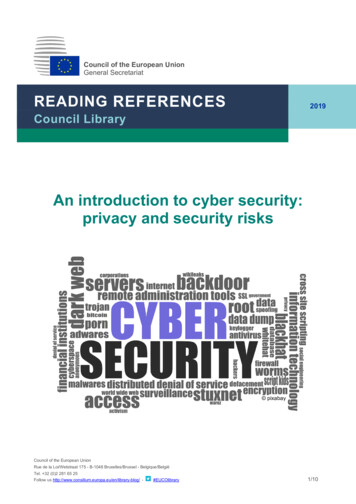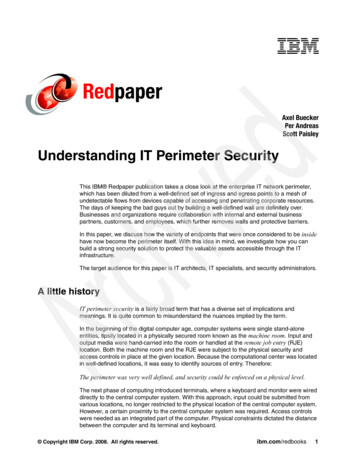
Transcription
PRODUCT EXPLORATIONSecuring Boundaries with Perimeter andIntrusion Detection TechnologiesSharpen Your SensesPerimeter security and physical intrusion detection are crucial for critical infrastructureand large-scale commercial complexes. Whether for government and military facilities orcommercial-industrial areas, having a reliable and efficient risk-deterrent system on theperimeter of any important site is now mandatory. On a global scale, there is much room forgrowth — IMS Research forecasts that in 2011 the intrusion detection market will surpassUS 2.4 billion, and the perimeter security market will reach about 400 million. a&s exploresthe latest market update and technological developments in perimeter and intrusion detection,as well as key considerations for selecting and installing a complete system.BY CAMILLE SHIEH3822AUG 2011www.asmag.com2222AUG 2011www.asmag.com2239
PRODUCT EXPLORATIONMarket potential andsales performance forperimeter securityand intrusion detection productsdepend on the region or country’srecovery from the recent recession,according to industry experts.Retrofit projects tend to take place inmature markets, while new projectsoccur in emerging markets. “Theincrease in demand is almost directlyrelated to a country’s GDP growthrate and economic recovery,” saidLuc Joosens, Detection ProductManagement Leader for EMEA, UTCFire & Security. “Countries that haveexperienced economic recovery in2010 have demonstrated an increaseddemand for intrusion detectionsystems.”The Americas and Asia marketshave strong demand for perimeterand intrusion detection products."The Asian markets have beendriven by construction growth,low unemployment, high GDP, agrowing middle-class and increasedgovernment spending," said BlakeKozak, Market Analyst for IMSResearch. "The American intrusionmarket is forecast to be especially indemand because of the move awayfrom traditional PSTN communications toward GPRS and wirelessconnectivity."“The Gulf region is a growthmarket for us, and we are activelydeveloping our base there,” saidStewart Dewar, PM of Senstar. “Interms of emerging markets, Indiacontinues to hold opportunityfor perimeter intrusion detectionsystem (PIDS) companies as doMexico, Colombia and Brazil. Wehave also recently opened an officein Singapore to address this regionmore aggressively.”Several manufacturers concurwith IMS Research's prediction onthe perimeter security and intrusiondetection markets. “To achieveUS 570 million in 2014, the marketwould need to experience growthmore than three times over what wasseen from 2009 to 2011,” said DavidCurtiss, Director of Engineeringat Smarter Security Systems.“While that type of growth seemsaggressive, government programsare placing requirements on criticalinfrastructure facilities that will needto be fulfilled. Also, there are newvideo management and analytictechnologies now offered to replaceor augment existing infrastructure.”Conservative players have For critical infrastructure, the requirements for intrusion detection are moving toward higher security, meaning better capture performance, signal analysis and communication solutions.4022AUG 2011www.asmag.com2222AUG 2011www.asmag.com2241
PRODUCT EXPLORATIONless bullish estimates, althoughthey agree that GDP growth andgovernment programs will drivethis market. “The US market, forinstance, will turn around over thenext couple of years with regulations such as Chemical FacilityA n t i - Te r ro r i s m S t a n d a rd s f o rthe petrochemical industry. TheInternational Ship and Port FacilitySecurity Code in relation to theseaport market is already impactingperimeter security business in Africaand other places,” Dewar said.“The next three years should givethe sluggish markets, particularlyin Europe, time to rebound and getback on track. In many cases, projectshave not been cancelled but ratherdelayed or pushed off to deal withthe economic challenge.”Others are even more optimistica b o u t p o t e n t i a l g ro w t h . “ T h eworldwide perimeter securitymarket should reach even morerobust levels as new technologiesare integrated into comprehensivesolutions,” said James Ionson, CEOof Oncam Global. “Open perimeters,such as deserts or waterways, withfew, if any, obstacles to access,present new challenges for theindustry to address. The spike inpiracy at sea and terrorist activitycan be expected to result in the needLuc Joosens, Detection ProductManagement Leader for EMEA, UTCFire & SecurityStewart Dewar, PM of Senstarfor enhanced security systems forboth commercial and luxury travelvessels, as they extend surveillancefrom a liability focus to also includeperimeter security.”SPICING UP OLD FENCESPerimeter security and intrusiondetection products are more complexand powerful than ever. End-userbehavior has also shifted from usingindividual products to combiningvarious detectors and sensors forholistic protection. “As a result of thefact that basic detection technologyhas been getting better and moreadvanced, the coverage of differentrisks is currently much better thansome years ago,” said JuergenGrasmehr, Global Portfolio ManagerIntrusion and Perimeter Systems,Siemens Building Technologies.DIFFERENT TYPES OF INTRUSION DETECTION For fence climbing detection: microphonic cable, active IR (AIR) beams For detection of entry in open spaces: AIR beams, outdoor microwave, outdoormotion detection, video surveillance For abandoned object detection: VCA For detection of penetration of roofs and walls: microphonic cable For forced opening of shielded spaces detection (for instances water tanks,vaults, gun cabinets): Seismic sensors For detection of the opening of doors/windows: contacts, shock sensors For window glass breaking detection: acoustic glass-break sensors For detection of entry in a room: motion sensors and video surveillanceSource: UTC Fire & Security4222AUG 2011www.asmag.com22James Ionson, CEO of Oncam Global“It is now possible to cover almostany kind of areas or objects, suchas fences, walls, ground, water, air,building roofs and building facades.Together with other technologieslike video surveillance, it is nowpossible to have very high detectionquality combined with an automatic,sophisticated verification thanks toautomatic camera tracking, zooming,object classification, visualization inoverview maps and the like.”One way to provide greater securityat critical infrastructure sites is tocombine multiple security technologies. “Indoor detection systemscan be expanded with perimeterprotection for advanced warning,while multiple technologies can becombined in the perimeter protection,such as fence and active IR; fence andmicrowave; motion and video surveillance; or combinations of these,”Joosens said. “Improved anti-maskingtechnology reports sabotage attemptsto the security system, and finally theincreased use of video surveillancecameras with higher image qualityand longer range provides bettersecurity at key sites.”IR with microwave, quad pyroelements, multicurtain laser and 3-Ddetection based on time-of-flighttechnology are some examples ofbasic detection technology becoming22AUG 2011www.asmag.com2243
PRODUCT EXPLORATIONmore advanced, Grasmehr said.“Also, detector information can bedelivered faster and more preciselyw i t h c u r r e n t t e c h n o l o g y. F o rinstance, placing a number of alarmsin a specific zone from differentdetectors can increase or decrease thereal alarm probability.”For outdoor detectors, theincreased development quality,as well as manufacturing qualityof electronics and mechanics, ismanifested in affordable high-endproducts such as laser scanners,radar detectors, high-end fiberoptical detection systems or piezodynamic sensors, Grasmehr said.“New sensor systems are moreflexible, and in some it is possiblet o ru n a n d c o m b i n e m u l t i p l e ,complex detection algorithms onone detector at the same time. Forinstance, a laser scanner is able todetect small object in one area andlarge object in another area.” Dualmotion sensing technologies — suchas double passive infrared (PIR)or PIR with microwave — are alsogaining popularity, as combinationsare capable of achieving higher falsealarm immunity, Joosens said.“Using the latest K-band dualtechnology, this kind of sensorverifies the PIR signals with themicrowave signal prior to any alarmdecision and is less likely to triggerfalse alarms as K-band microwavesdo not penetrate walls and glass aseasily,” explained Tony Makosinski,External and Security IndustryL i a i s o n , H o n e y w e l l S e c u r i t y.“Therefore, faster and more reliabledetection is achieved, and falsealarms and associated interventioncosts are reduced. As this technologybecomes more developed, it isincreasingly taken up by the rest ofthe industry.”4422AUG 2011Tony Makosinski, External andSecurity Industry Liaison, HoneywellSecurityJason Burger, Sales and MarketingManager, Navtech RadarFor fences, cable sensors deployingfiber optics and coax are prevalenttoday, said Curtiss. “For fenceswith detectors, PIR detectors offersuperior performance when complemented with a perimeter securitysystem in areas such as gates, roadsor any location that may requiretrenching.”Buried fiber-optic systems appearto be taking the lead versus radiofrequency/leaky coaxial types ofsensors in underground detectiondue to their immunity to water,lighting and soil conditions, saidDavid Smith, CEO of Optellios.“Although fiber optic technologyis not new, the prevalence of itsuse in security deployments is onthe rise compared to strain gauge,microphonic and shaker systems,because it is easy to install.” Fiberrequires no electronics on the fence,no additional power and is immuneto lightning and radio interference.It has sufficient bandwidth to handlevideo and access control communication.Detection technologies initiallydeveloped for military applications,such as radar detection, are morecommon in civil security projects,Grasmehr added. “The radar systemcould detect and track a person froma considerable distance before hewww.asmag.com22Dennis Petricoin, VP of ProductManagement for IntrusionDetection, Bosch Security Systemsor she is even near the fence or upto the fence line, and continues totrack once the person has entered thefenced perimeter,” said Jason Burger,Sales and Marketing Manager,Navtech Radar. “Radar does notrequire light or good weather tofunction, and would work in all lightand weather conditions.”“Some airports are using radararrays that are configured to detectmovement in both the X and Yaxes. This data is then combined toproduce a 3-D display of the target,”Curtiss said.SOFTWARE POWERSPSIM and mapping software arecoming into the spotlight with moreofferings from established leadersand startups, especially for criticalsites operating with multiple securitysystems. “The ability to integratethe many disparate security devicesand locations within an organizationinto a common operating platformthat enables efficient assessmentand response from a commandand control center as well as fieldpersonnel is highly desirable,”Curtiss said. For entry-level securitymanagement, alarm integrationmodules enable fast deploymentinterfaces to other securitysubsystems, using dry contacts for22AUG 2011www.asmag.com2245
PRODUCT EXPLORATIONhandshaking, Dewar said.To facilitate integration betweenPIDS sensors and a securitymanagement system (SMS), itrequires several things from the PIDSvendor. “First, a well thought-outsoftware architecture — one thatprovides sensor management toolsthat can be used at the same timethe PIDS software is exchanginginformation with the SMS, and onethat allows the SMS to do a queryfor the current status of all sensors,”Dewar said. “By having thiscapability, after a power-up or restart,the SMS can quickly be synchronizedto the state of the perimeter system.Second, a comprehensive SDK isrequired that clearly documents theprotocol by which alarm and statusinformation is exchanged and thatprovides a high-fidelity simulator soall sensor events can be simulatedin software to test the eventualintegration.”The addition of video surveillance and VCA maximizes theeffectiveness of a perimeter orintrusion detection system, whichcan both be managed throughcentral management software. Videoverification is carried out by PIRthat triggers a camera and sendssnapshots or a compressed videoclip via the control panel to themonitoring station or directly to theend user for verification of the alarm,Joosens explained. “Both wiredvideo verification systems as well aswireless video verifications systemsexist, but as the distribution of theimages is handled by the controlpanel, the systems are typicallyproprietary to the control panelmanufacturer and interoperablewith other intrusion systems. Thereare major differences in the varioussystems on the market in terms of thetype of image sent, the image qualityand the transmission time.”“Video verification and analyticsis a necessary combination that endusers need to implement if they can.Let the PIDS detect the intruderand let the video provide the videosurveillance to determine theappropriate response,” Smith said.Video surveillance solutions thatinterrogate and verify potentialthreats enhance the effectivenessVideo verification andanalytics are a highlyrecommended combinationthat can be used alongsideperimeter security andintrusion detection.4622AUG 2011www.asmag.com22and efficiency of perimeter securitysystems, Ionson said. “They enabletimely and measured responses whiledramatically reducing costly falsealarms. Using 360-degree imaging,with its total situational awareness,to trigger a colocated PTZ camera toquickly zoom in on a suspicious eventincreases both the speed and accuracyof threat verification.”WHAT’S NEXT?Choosing the right perimetersecurity and intrusion detectionproducts depends on the site thatthey are supposed to protect. Thereis no one solution for all perimetersecurity applications and eachapplication should be approachedwith this knowledge, Dewar said.“While specific challenges from siteto site still exist, the introductionof standards across the board hasled to significant advancements inthe reliability of physical intrusionsystems,” Makosinski said.When considering criticalinfrastructure, the requirementsfor intrusion detection are movingtoward higher security, meaningbetter capture performance, bettersignal analysis and better communication solutions, with multiple pathsand better integration into othersubsystems, said Dennis Petricoin,VP of Product Management forIntrusion Detection, Bosch SecurityS y s t e m s . “ We c o n t i n u e t o s e eintegration and flexibility as a keypart of the industry’s future.”Selecting suitable products thatsatisfy end user requirements is onlypart of the equation. The second partof this feature explores key considerations system integrators shouldpay attention to during and afterinstalling a perimeter and intrusiondetection system.
For detection of entry in open spaces: AIR beams, outdoor microwave, outdoor motion detection, video surveillance For abandoned object detection: VCA For detection of penetration of roofs and walls: microphonic cable For forced opening of shielded spaces detection (for instances water tanks, vaults, gun cabinets): Seismic sensors











